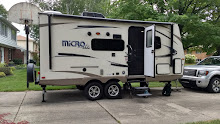Wed. June 12: On our short drive from
Portland to Seaquest State Park in Washington, just off I5 and on the way to
Mount St. Helens, we had a nice phone conversation with our friend Jessica
Martinson’s dad, Bob. He and her mom, Suzanne, live in Longview, where Jessica
was born, thought they have all lived elsewhere in between. More importantly
they were living there when Mount St. Helens erupted in 1980 and Bob was
working was on the local newspaper team that won a Pulitzer Prize for their
coverage of the eruption. He was very gracious and invited us to stop by but we
knew we needed to get there and get set-up in order to have enough of the day
to explore the area. We took a nice site with no electricity at the campground
and left the camper without setting up. Our first stop was at the Mount St.
Helens State Park Information Center across the highway from our campground.
But they charged admission for their displays so we decided to wait on that. It
was a 54 mile drive to the Johnston Ridge Observatory in the Mount Saint Helens
National Volcanic Monument (or MSHNVM). Much of the way it was pretty cloudy
and we decided that we should take pictures any chance we had any view of the
mountain at all because it might not get any better. Along the way there were
other museums and visitors centers, including one by the Weyerhauser
Corporation overlooking the wasteland left by the huge mudslide that rushed
down the Toutle River after the eruption. There are frequently elk herds
roaming in the valley but we didn't see any when we stopped there to eat our
picnic lunch. As we drove through that area, about 20 miles outside the
monument, there were interpretive signs telling when we entered the “Blast
Area” and explaining Weyerhauser’s plan for managing the forest by harvesting
some of the fallen old growth trees that weren't incinerated and then skipping
a few forest succession steps by replanting the hillsides with pine trees. 33
years of growth has resulted in the reforesting of many miles. This is a real
contrast to the Monument, which was set aside by Congress to allow the
scientific study of how Mother Nature would replenish and rebuild in her own
way. The land on the outskirts of the Monument has gone through several stages
of wildflowers and now is heavily covered with alder trees only a few years
old. Closer to the mountain, where the blast literally scraped the top soil off
down to the rock there is still a lot of totally barren ground. The fabled
beauty of the symmetrical cone-shaped Mount Saint Helens has given way to a
stark but utterly fascinating landscape unlike anything else we have seen. The
Observatory/Visitors Center is very well done and combines the scientific data
and information on what occurred on May 18, 1980 (only the most recent of its
many eruptions) with the human interest stories of those who lost their lives,
including the young volcanologist for whom the ridge is now named, or who barely
escaped with their lives. We spent a couple hours there going through their
exhibits; watching two movies, one on the eruption and one on how nature is
restoring the area; and heard two ranger presentations, both expert and very
rapidly and dramatically done. While we were there we got some views of the
mountain that were nearly clear of clouds and then fog, rain and clouds rolled
in, almost completely obscuring any view. We took two short hikes in the 42°
drizzle and made the return drive with rain most of the way.
.JPG) |
| Just inside the blast zone they've built this new bridge |
.JPG) |
| Mount Saint Helens' new look |
.JPG) |
| Penstemon was flowering abundantly |
.JPG) |
| A picture of a wet display board showing Mount Saint Helens on a clear day |
.JPG) |
| Trees still lie upon the ground on Johnston Ridge where the blast tore away everything down to bedrock |
.JPG) |
| The clearest shot we had of the new crater |
.JPG) |
| A picture of how the old Mount Saint Helens looked |
Back at the campground the rain had stopped. We ate Teriyaki Rice with ground beef and salad. Then we took about a two mile hike down to the Information Center and around the wetland trail there. It was very quiet and peaceful with many frogs and birds calling as twilight fell. In the camper we watched a Northern Exposure and cuddled under the MSU fleece blanket Jen made us to stay warm.
.JPG) |
| From the wetlands trail |
.JPG)
.JPG)
.JPG)
.JPG)
.JPG)
.JPG)
.JPG)
.JPG)
.JPG)
.JPG)

See I write the comment, I ask to preview, nada. I ask to publish without preview, also nada. Crazy making
ReplyDeleteSo now I logged into blogspot since I do have a couple pages here (doing nada). This seems to be the trick, but sure limits the people who can comment!
ReplyDeleteI did not remember Mt. St. Helens erupting the year Stephanie (and Sarah) were born! I recall both the Iran hostage crisis and John Lennon being killed, but not this. Nature is devastatingly powerful. Losing those firefighters in AZ yesterday is a testament to that yet again :( I'm glad they are doing both the research on natural recovery and the enhanced reforestation. The comparison will provide info too. All so interesting.
So glad you got a comment to show! I changed one setting...maybe that made a difference?
ReplyDelete